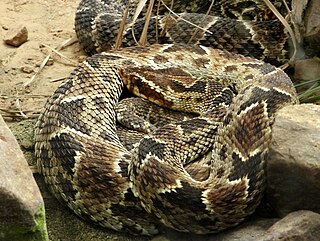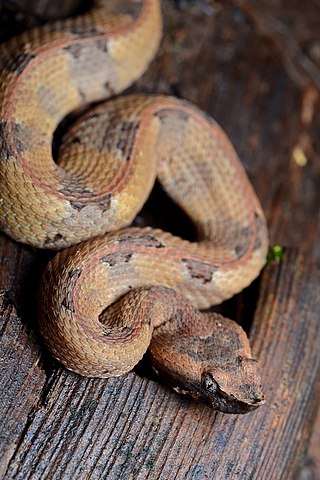
Metlapilcoatlus is a genus of venomous pit vipers endemic to Mexico and Central America. Six species are currently recognized. The common names suggest they are able to leap at an attacker, but this is likely exaggerated. Common names for the species include jumping pitvipers and jumping vipers. The genus name comes from the Nahuatl name metlapilcohuatl, which means of the oblong grindstone held in the hand when grinding corn - alluding to the snakes short stocky body.

Bothrops is a genus of highly venomous pit vipers endemic to the Neotropics. The generic name, Bothrops, is derived from the Greek words βόθρος, bothros, meaning "pit", and ὄψ, ops, meaning "eye" or "face", together an allusion to the heat-sensitive loreal pit organs. Members of this genus are responsible for more human deaths in the Americas than any other group of venomous snakes. Currently, 48 species are recognized.

Protobothrops jerdonii, also known commonly as Jerdon's pitviper, the yellow-speckled pit viper, and the oriental pit viper, is a species of venomous snake in the subfamily Crotalinae of the family Viperidae. The species is native to India, Nepal, Myanmar, China, and Vietnam. Three subspecies are recognized, including the nominate subspecies described here.

Craspedocephalus macrolepis, commonly known as the large-scaled pit viper, is a venomous pitviper species endemic to the Southern Western Ghats of South India. No subspecies are currently recognized.

Bothriechis is a genus of venomous pit vipers, commonly called palm vipers or palm-pitvipers found predominantly in Mexico and Central America, although the most common species, B. schlegelii, ranges as far south as Colombia and Peru. All members are relatively slender and arboreal. The name Bothriechis is derived from the Greek words bothros and echis that mean "pit" and "viper" respectively. Ten species and no subspecies are currently generally recognized.

Cerrophidion is a genus of venomous pitvipers which are endemic to southern Mexico, Central America, and western Panama. The generic name, Cerrophidion, is derived from the Spanish word cerro, which means "mountain", and the Greek word ophidion, which means "small snake". Five species are recognized as being valid, but no subspecies are.

Agkistrodon bilineatus is a highly venomous pit viper species found in Mexico and Central America as far south as Honduras.

Bothrops barnetti, also known commonly as Barnett's lancehead and Barnett's pit viper, is a species of venomous snake, a pit viper in the subfamily Crotalinae of the family Viperidae. The species is endemic to Peru. There are no subspecies that are recognized as being valid.
Bothrops pirajai is a species of venomous snake, a pit viper in the subfamily Crotalinae of the family Viperidae. The species is endemic to Brazil. There are no subspecies that are recognized as being valid.

Crotalus transversus, or the Cross-banded Mountain Rattlesnake, is a venomous pit viper species found in central Mexico, known from less than 20 specimens. No subspecies are currently recognized.

Crotalus triseriatus is a venomous pit viper species found in Mexico. Two subspecies are currently recognized, including the nominate subspecies described here.

Bothriechis bicolor is a venomous pit viper species found in southern Mexico, Guatemala and Honduras. The specific name refers to the contrasting ventral and dorsal colors. No subspecies are currently recognized.
Crotalus lorenzoensis is a species of pit viper.

Metlapilcoatlus nummifer, commonly known as Mexican jumping pitviper or jumping viper, is a venomous pit viper species endemic to Mexico.

Bothriechis aurifer is a venomous pit viper species found in Mexico and Guatemala. No subspecies are currently recognized.

Bothriechis marchi, also known as Honduran palm pit viper and March's palm pit viper, is a species of pitviper, a venomous snake, in the subfamily Crotalinae of the family Viperidae. The species is endemic to Central America. There are no subspecies that are recognized as being valid.
Mixcoatlus barbouri is a venomous pit viper species endemic to Mexico. No subspecies are currently recognized.

Cerrophidion tzotzilorum is a venomous pit viper species which is native to southern Mexico. There are no subspecies that are recognized as being valid.

Porthidium nasutum is a venomous pitviper species found in southern Mexico, Central America and northern South America. No subspecies are currently recognized.

Porthidium lansbergii is a species of venomous snake, a pitviper in the family Viperidae. The species is endemic to Central and South America. Four subspecies are recognized, including the nominate subspecies described here.


















